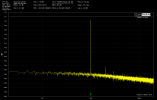I think that we all agree what the classes mean

. It's only that D. Self has adapted the notion a bit.
This is his definition of class B:
"My definition of Class-B is that unique amount of bias
voltage which causes the conduction of the two output
devices to overlap with the greatest smoothness and so
generate the minimum possible amount of crossover
distortion. For a single pair of output devices the quiescent current will be of the order of 10 ma for a CFP
output stage, or 100 mA for the EF version. With
bipolar transistors, collector current tails off exponentially as Vbe is reduced, and so the conduction period
is rather arguable, depending on what current you
define as ‘conducting’."


